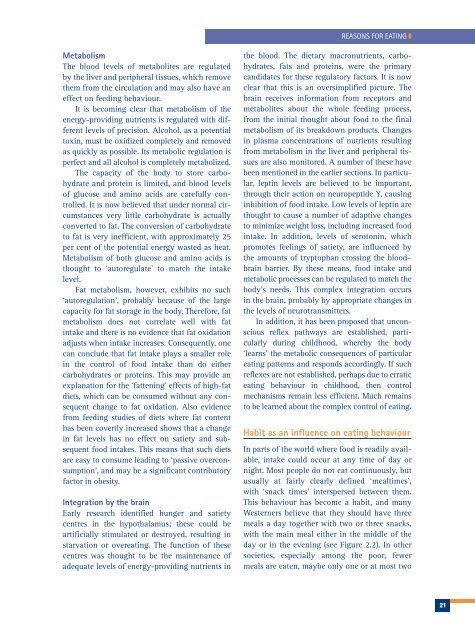Human Nutrition
Human Nutrition
Human Nutrition
You also want an ePaper? Increase the reach of your titles
YUMPU automatically turns print PDFs into web optimized ePapers that Google loves.
REASONS FOR EATING ❚<br />
Metabolism<br />
The blood levels of metabolites are regulated<br />
by the liver and peripheral tissues, which remove<br />
them from the circulation and may also have an<br />
effect on feeding behaviour.<br />
It is becoming clear that metabolism of the<br />
energy-providing nutrients is regulated with different<br />
levels of precision. Alcohol, as a potential<br />
toxin, must be oxidized completely and removed<br />
as quickly as possible. Its metabolic regulation is<br />
perfect and all alcohol is completely metabolized.<br />
The capacity of the body to store carbohydrate<br />
and protein is limited, and blood levels<br />
of glucose and amino acids are carefully controlled.<br />
It is now believed that under normal circumstances<br />
very little carbohydrate is actually<br />
converted to fat. The conversion of carbohydrate<br />
to fat is very inefficient, with approximately 25<br />
per cent of the potential energy wasted as heat.<br />
Metabolism of both glucose and amino acids is<br />
thought to ‘autoregulate’ to match the intake<br />
level.<br />
Fat metabolism, however, exhibits no such<br />
‘autoregulation’, probably because of the large<br />
capacity for fat storage in the body. Therefore, fat<br />
metabolism does not correlate well with fat<br />
intake and there is no evidence that fat oxidation<br />
adjusts when intake increases. Consequently, one<br />
can conclude that fat intake plays a smaller role<br />
in the control of food intake than do either<br />
carbohydrates or proteins. This may provide an<br />
explanation for the ‘fattening’ effects of high-fat<br />
diets, which can be consumed without any consequent<br />
change to fat oxidation. Also evidence<br />
from feeding studies of diets where fat content<br />
has been covertly increased shows that a change<br />
in fat levels has no effect on satiety and subsequent<br />
food intakes. This means that such diets<br />
are easy to consume leading to ‘passive overconsumption’,<br />
and may be a significant contributory<br />
factor in obesity.<br />
Integration by the brain<br />
Early research identified hunger and satiety<br />
centres in the hypothalamus; these could be<br />
artificially stimulated or destroyed, resulting in<br />
starvation or overeating. The function of these<br />
centres was thought to be the maintenance of<br />
adequate levels of energy-providing nutrients in<br />
the blood. The dietary macronutrients, carbohydrates,<br />
fats and proteins, were the primary<br />
candidates for these regulatory factors. It is now<br />
clear that this is an oversimplified picture. The<br />
brain receives information from receptors and<br />
metabolites about the whole feeding process,<br />
from the initial thought about food to the final<br />
metabolism of its breakdown products. Changes<br />
in plasma concentrations of nutrients resulting<br />
from metabolism in the liver and peripheral tissues<br />
are also monitored. A number of these have<br />
been mentioned in the earlier sections. In particular,<br />
leptin levels are believed to be important,<br />
through their action on neuropeptide Y, causing<br />
inhibition of food intake. Low levels of leptin are<br />
thought to cause a number of adaptive changes<br />
to minimize weight loss, including increased food<br />
intake. In addition, levels of serotonin, which<br />
promotes feelings of satiety, are influenced by<br />
the amounts of tryptophan crossing the blood–<br />
brain barrier. By these means, food intake and<br />
metabolic processes can be regulated to match the<br />
body’s needs. This complex integration occurs<br />
in the brain, probably by appropriate changes in<br />
the levels of neurotransmitters.<br />
In addition, it has been proposed that unconscious<br />
reflex pathways are established, particularly<br />
during childhood, whereby the body<br />
‘learns’ the metabolic consequences of particular<br />
eating patterns and responds accordingly. If such<br />
reflexes are not established, perhaps due to erratic<br />
eating behaviour in childhood, then control<br />
mechanisms remain less efficient. Much remains<br />
to be learned about the complex control of eating.<br />
Habit as an influence on eating behaviour<br />
In parts of the world where food is readily available,<br />
intake could occur at any time of day or<br />
night. Most people do not eat continuously, but<br />
usually at fairly clearly defined ‘mealtimes’,<br />
with ‘snack times’ interspersed between them.<br />
This behaviour has become a habit, and many<br />
Westerners believe that they should have three<br />
meals a day together with two or three snacks,<br />
with the main meal either in the middle of the<br />
day or in the evening (see Figure 2.2). In other<br />
societies, especially among the poor, fewer<br />
meals are eaten, maybe only one or at most two<br />
21

















